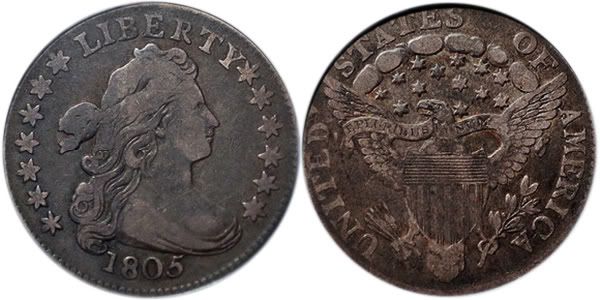Critique this Draped Bust Dime
 FilamCoins
Posts: 1,900 ✭✭✭
FilamCoins
Posts: 1,900 ✭✭✭
Dark and ugly or original and attractive? Decent strike or weak for type? VG? F? VF? All comments welcome.

0
Comments
PCGS Registries
Box of 20
SeaEagleCoins: 11/14/54-4/5/12. Miss you Larry!
Nice coin!
I think it's quite attractive and would go well in any medium to high end type set.
I say this because years ago there was VF grade 1805 dime floating around at the Florida shows with ANACS papers. The photo of the coin in the papers looked great, but actual coin had what could be called chemical damage and looked awful. The coin had not been switched; it had simply “gone bad” since ANACS had graded it.
The only conclusion I could make was that the coin had been treated with something to tone and that the toning stuff had just kept going to the point of damage.
AnkurJ: Thanks for saving it for me!
Stone: PCGS called it F-15. Thanks.
LanLord: Thanks. Going into a mid-range type set.
BillJones: Thanks. I'll investigate the slab/treatment issue.
<< <i>AnkurJ: Thanks for saving it for me!
Stone: PCGS called it F-15. Thanks.
LanLord: Thanks. Going into a mid-range type set.
BillJones: Thanks. I'll investigate the slab/treatment issue. >>
Isn't is great when a bunch of really smart guys give their help and insight for free.
This is what these boards are for.
Tom
edited to add: looks 20 from here, 15 is pretty conservative, but the larger, clearer pics may help us figure out where the rest of the points went, in their minds.
I do like the dark toning, and the strike looks average for the series, somewhat weak on the obverse, fuller on the reverse with characterisic localized weakness
Liberty: Parent of Science & Industry
<< <i>wouldnt it make sense that if a coin sat one side down for many years, that one side would be lighter than the other ? i used to own a nice XF 1843-o dime that was glossy black on one side and medium grey on the other, no evidence of being anything other than a coin that sat somewhere for a long time and developed more tarnish on one side. >>
Absolutely! I have several Wayte Raymond silver albums in which the coins have been sitting for 40-50 years. The reverses are much more deeply toned than the obverses.